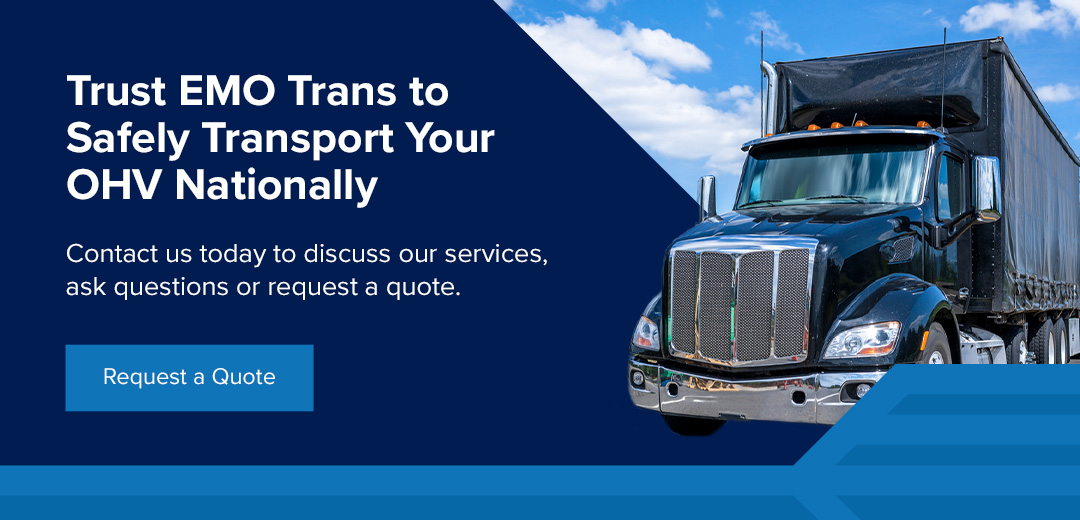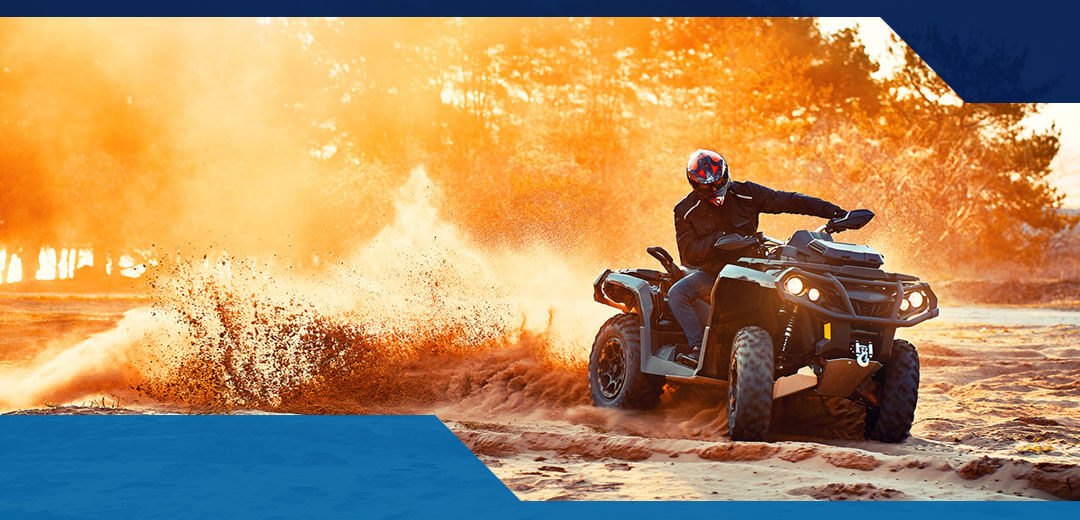
OHV stands for off-highway vehicle, and this umbrella term includes a wide range of vehicles intended for off-road use. Vehicles that fall into this category include all-terrain vehicles (ATVs), utility task vehicles (UTVs), recreational off-highway vehicles (ROVs), snowmobiles, dirt bikes, and even four-wheel drive (4WD) vehicles like Jeeps or certain sport utility vehicles (SUVs).
Whether you own an OHV or are looking to buy one, it’s good to know what options are available and their intended use. If you’re looking to buy a youth quad bike for your children to enjoy, a robust UTV for farm work, a dirt bike for off-road racing or another OHV, this off-highway vehicle guide will help you understand the common types and explain how you might transport them.
What Are Off-Highway Vehicles?
Off-highway vehicles are motor-driven, but unlike conventional vehicles, they are designed specifically for off-road use or natural terrains.
These vehicles navigate the tricky, rough, uneven and sometimes steep terrain that regular on-road cars are not built to handle. OHVs are often used for recreational purposes, but they also serve in the agricultural, construction and mining industries, among others.
Some of the common characteristics that will help you identify an OHV include:
- Large tires with deep treads: These are crucial for providing traction on loose and uneven ground.
- Flexible suspension systems: This is important for improved maneuverability and stability on rough terrain.
- High ground clearance: Off-road driving often involves large obstacles and uneven ground that a higher clearance helps drivers avoid.
- Powerful engines: Off-road driving is incredibly demanding, and vehicles need that extra power that ordinary cars don’t possess. Perhaps not always in speed, but certainly in torque.
- Durable construction: The materials used for these vehicles are tough and durable to withstand harsh conditions and heavy use.
Additionally, although many OHVs are open-air, several options are enclosed. They may come equipped with winches, roll cages, an additional spare tire and, less commonly, self-inflating tires.
6 Types of Off-Highway Vehicles
Explore the following prime OHV examples.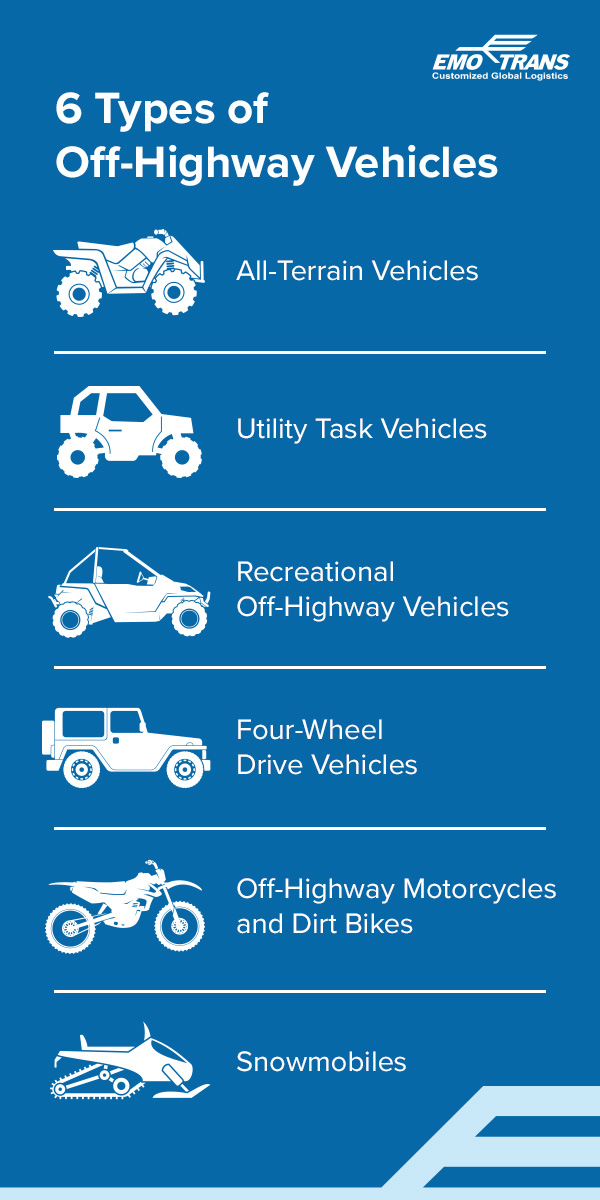
1. All-Terrain Vehicles
ATVs are versatile off-road vehicles that can often fit in spaces that other OHVs cannot. Commonly referred to as four-wheelers or quad bikes, they have motorcycle-like seating and handlebar steering. They are categorized by four large, low-pressure tires that provide excellent traction. They are also open-air vehicles and do not have roll cages or any other protective structures.
There are subtypes and variations of ATVs, such as:
- Sport ATVs: These are built for speed and agility and are used in racing or for recreational riding. They tend to have a lightweight frame and a powerful engine.
- Utility ATVs: These are often bulkier and designed for work purposes. They are typically found on farms, construction sites, or other relevant industries. Their robust builds normally accommodate attachments like plows or trailers.
- Youth ATVs: Youth ATVs are smaller and less powerful. They are designed for younger riders and come with safety features like speed limiters and remote shut-off.
The general characteristics of ATVS are:
- Four-wheel drive or two-wheel drive (2WD).
- High ground clearance.
- Durable construction.
- Handlebar steering.
2. Utility Task Vehicles
UTVs, often referred to as side-by-sides, are off-road vehicles designed for both work and recreation. Unlike ATVs, UTVs typically have side-by-side seating for between two and six passengers, which makes them ideal for group activities and tasks that require a team.
Like ATVs, there are different variations of UTVs:
- Work UTVs: Built for heavy-duty tasks, these UTVs are commonly used in agriculture, landscaping and construction. They usually feature a cargo bed, towing capabilities and the ability to support various attachments.
- Sport UTVs: These are designed for high performance. They are used in racing and recreational off-roading, typically on gravel or farm roads. They have powerful engines and advanced suspension that make them agile and speedy.
- Hybrid UTVs: These combine the features of work and sports UTVs. They are ideal for people who use their UTVs for work but also want to use them for fun.
The general characteristics of UTVs include:
- Side-by-side seating.
- Roll cages and seat belts.
- Four-wheel drive or all-wheel drive (AWD).
- Cargo space.
3. Recreational Off-Highway Vehicles
ROVs are designed primarily for leisure and adventure activities. They are similar to UTVs, but they are built specifically for recreational use and offer a thrilling off-road experience.
Here’s how you can use your ROV:
- Off-road racing: These high-performance vehicles are designed for speed and agility. They have powerful engines and advanced suspension systems, and they are often used in off-road racing and extreme sports.
- Exploring trails: Built for exploring trails and rugged terrain, these vehicles offer occupants a balance of power and comfort. They have features that enhance the off-road experience, such as comfortable seating and GPS systems.
- Doing family activities: Because they are designed to accommodate more passengers, ROVs are perfect for family outings and group adventures. They usually come equipped with spacious interiors and safety features like rollover protective structures.
The general characteristics of ROVs include:
- Side-by-side bucket seating.
- Roll cages and seat belts.
- Steering wheel controls.
- Four-wheel drive.
- Advanced suspension systems.
4. Four-Wheel Drive Vehicles
Four-wheel drive vehicles are designed to provide power to all four wheels, which offers superior traction and control when tackling challenging terrain. These vehicles are often used for on-road and off-road applications, making them a versatile choice for many users. Many modern 4WD vehicles can switch between 2WD and 4WD, depending on the driver’s needs.
There are a wide range of 4WD vehicles available, but here are some of the variations:
- Jeeps: A Jeep is considered an OHV, and it is known for its rugged build. Jeeps are popular for adventure enthusiasts, and many iconic models are available. The Jeep Wrangler, for example, is known for its durability and performance in rough conditions.
- Trucks: Off-road trucks, such as the Ford F-150 Raptor and Toyota Tacoma TRD Pro, are built to handle heavy loads and rugged terrain. With their powerful engines and robust suspensions, they are ideal workhorses and off-road adventure vehicles.
- SUVs: Vehicles like the Ford Bronco and Land Rover Defender offer a wonderful blend of luxury and off-road capabilities. While you will often see them driving around the city, they are also suited to off-road excursions. SUVs’ comfortable interiors and outstanding performance make them worthy members of the list of 4WD vehicles.
The general characteristics of four-wheel-drive vehicles are:
- High ground clearance.
- Durable construction.
- Advanced suspension.
- Enhanced comfort.
- Dual use as on and off-road vehicles.
5. Off-Highway Motorcycles and Dirt Bikes
OHV motorcycles and dirt bikes are designed specifically for off-road use — however, there are some hybrid options, too. Dirt bikes and off-highway motorcycles offer agility, speed and the ability to navigate challenging terrain that not even ATVs can handle at times. These two-wheel vehicles are popular among enthusiasts for recreational riding, racing and exploring highly rugged terrain.
As with other kinds of OHVs, motorcycles and dirt bikes come in many varieties:
- Motocross bikes: These are built for racing on closed circuits with jumps, sharp turns and varied terrain. They are usually lightweight but have powerful engines and highly advanced, responsive suspension systems.
- Enduro motorcycles: Designed for long-distance off-road riding, these bikes have features that make them suitable for competitive and recreational use. They come with larger fuel tanks and more durable components than other bikes.
- Trail motorcycles: These are ideal for casual off-road riding, as they are versatile yet user-friendly. They look and feel similar to motocross bikes and are built to handle a variety of terrains, from forest trails to rocky paths.
- Dual-sport motorcycles: These are sometimes called dual-purpose and street-legal motorcycles — you can use them on and off the road. They offer an excellent balance between comfort and performance, which makes them ideal for riders seeking versatility.
The general characteristics of off-highway motorcycles and dirt bikes include:
- Lightweight frames.
- Knobby tires.
- High ground clearance.
- Rugged suspension systems.
- Minimalistic designs.
6. Snowmobiles
Snowmobiles are like motorized skis. Like ATVs, you use the handlebars to steer, brake and accelerate. Snowmobiles can be used for:
- Hunting and fishing: With snowmobiles, hunters can cover more ground quickly during the wintertime.
- Racing: Whether racing with friends or taking part in an International Snowmobile Racing competition, snowmobiles provide an exhilarating outdoor experience.
- Outdoor exploration: Snowmobiles can carry up to two passengers at a time, making them an excellent choice for exploring the outdoors with a partner or friend.
- Rescue missions: Snowmobiles also have more practical applications — in remote areas, they can be used to rescue stranded individuals or workers.
- Transportation: In rural areas, snowmobiles may work better than conventional vehicles during the winter season.
The general characteristics of snowmobiles include:
- Skis and ski handles.
- A front bumper.
- Handlebar steering and controls.
- A windshield.
- Motorcycle-style seating.
What Is the Difference Between UTVs and ROVs?
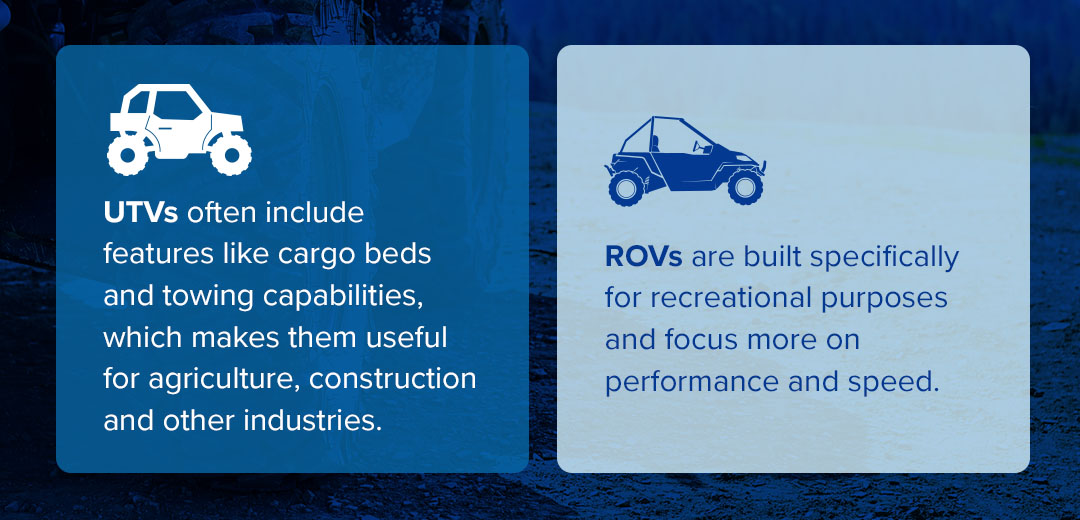
There are several similarities between UTVs and ROVs. Both offer side-by-side seating, steering wheel controls and 4WD systems. Additionally, both come with safety features like roll cages and seat belts.
However, the key difference between UTVs and ROVs is that UTVs are predominantly designed for work-related tasks. UTVs often include features like cargo beds and towing capabilities, which makes them useful for agriculture, construction and other industries.
In contrast, ROVs are built specifically for recreational purposes and focus more on performance and speed. ROVs can travel at faster speeds — typically more than 30 miles per hour — while handling a variety of terrains, which is why they are preferred for adventure sports and off-road racing.
Specific identifying characteristics of UTVs include:
- Cargo beds for transporting tools and supplies.
- Towing capabilities.
- Use in agriculture and construction industries.
Specific identifying characteristics of ROVs include:
- Higher speed capabilities.
- Advanced suspension systems for improved handling.
- Used for recreational and racing activities.
Does Each State Regulate OHVs Differently?
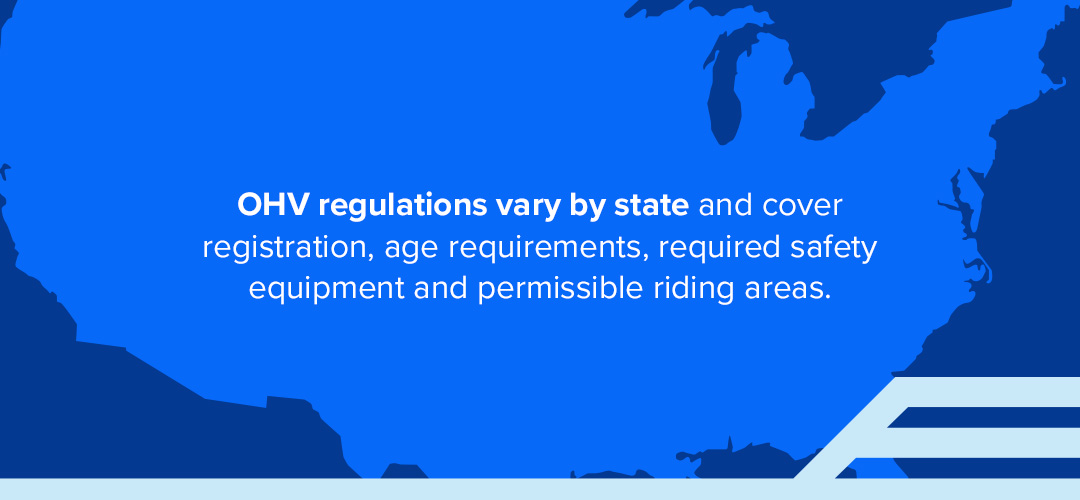
OHV regulations vary by state and cover registration, age requirements, required safety equipment and permissible riding areas.
For instance, some states require OHVs to display license plates, while others do not. Safety requirements like helmets and protective gear can also differ by state. Additionally, the designated trails and public lands where OHVs can legally operate are subject to state-specific rules.
As an OHV owner, you must familiarize yourself with the regulations in the respective states you wish to ride to ensure compliance and safe riding. Some best practices include:
- Respecting private property and abiding by signs.
- Wearing protective helmets.
- Staying clear of wildlife.
- Adding tall flags to your vehicle to ensure visibility.
How to Transport Off-Highway Vehicles
Transporting OHVs requires careful preparation to ensure safety and compliance with regulations. For instance, you’ll need to ensure the vehicle carrying the OHV does not exceed its gross vehicle weight rating, which varies by vehicle and state. With that in mind, here are the steps to preparing your OHV for transportation:
- Loading: Use secured ramps to load the OHV onto the transport vehicle or trailer safely.
- Securing: Use heavy-duty straps and chains to secure the OHV. Ensure it is tightly fastened to prevent movement during transport.
- Checking: Double-check that all connections and straps are secure to ensure the OHV is entirely stable.
When deciding how to transport your OHV, you have several options. These are the top three choices for most people:
- Trailers: You can transport your OHV using enclosed or open trailers. Remember to consider potential weather conditions when deciding. Many trailers provide ample space and protection from the elements. If you choose an open trailer, consider using a covering to protect your OHV.
- Pickup trucks: You can use a pickup truck bed to transport smaller OHVs, such as ATVs and dirt bikes. Ensure the truck has enough anchor points to properly secure your OHV and avoid shifting or sliding.
- Professional shipping services: This is a hassle-free option for long-distance transportation of your OHV. This service allows you to leave transportation to the professionals. You will also free yourself of the concerns of loading and unloading the OHV, as this is typically part of the service.
Trust EMO Trans to Safely Transport Your OHV Nationally
Off-highway vehicles are a significant investment, whether you use them for sport, leisure or work purposes. When transporting your OHV, you want complete peace of mind that the vehicle will be handled properly and arrive safely and on time. EMO Trans offers expert services to ensure you can transport your OHV as close or as far as you need. With our services, you can rest assured that your vehicle will be transported securely by experienced professionals in the business, as we have provided transport and logistics services since 1965.
Contact us today to discuss our services, ask questions or request a quote. We’ll happily assist you with your transport needs!

